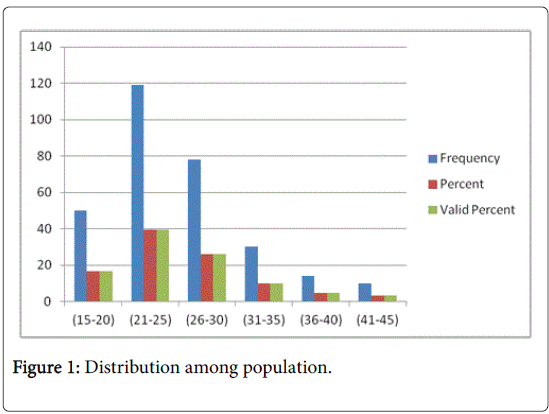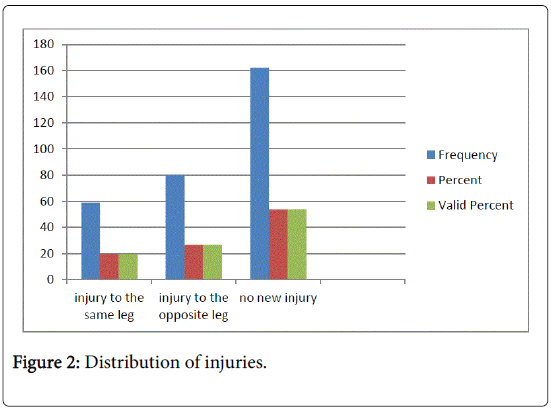Exploring Relation between Previous and Recent Injury to the Opposite Lower Limb with and without Physiotherapy Intervention
Received: 26-Jun-2018 / Accepted Date: 31-Jul-2018 / Published Date: 02-Aug-2018 DOI: 10.4172/2165-7025.1000395
Keywords: Recurrent injury; Risk factors; Physiotherapy intervention; Lower limb injury
Introduction
Numerous injuries occurring in both upper and lower extremities per year for different reasons [1]. Management of these injuries consuming a lot of money directly as medical and rehabilitation costs and indirectly as sick leaves [2]. For example, in Australia, sport injuries costing $1.5 billion per year [3]. According to the report, lower extremities injuries were twice than injuries to upper extremities and knee injuries were the most common and costly one. In fact, many studies concluded that ankle and knee injuries representing the majority of sport injuries [4-6]. In 2012, the number of operations done by orthopedic departments was 9210 operations in Omani government hospitals [7]. Out of these, 1429 operations were for joint structure, 984 on muscles and tendons.
In addition to all this costs, some complications can occur in the future as a result of previous injuries and again will consume more and more of healthcare funds. Furthermore, some studies found that history of previous injuries increasing the risk of new injuries in the future [8], for lower extremity muscles [9], for lower extremity [10] at knee [11] at ankle and knee [12] and at ankle [13].
Yet, the previous studies were concentrating on previous injury as risk factor for similar future injury occurring at the same leg and or the same area. Fewer studies focused on risk of contrateral lower limb injury as a result of previous injury with and without physiotherapy intervention. On the other hand, this study will look for any association between previous injuries in one lower extremity and later injuries occurred in the other lower extremity.
Method
After obtaining the ethical approval from the Research Committee, the data were collected from the computerized hospital documentation system.
Target population
All patients with lower limbs injuries managed at the orthopedic departments of Sohar hospital from March 2014 to Sept 2014 were included. They were distributed into 3 groups according to site of injury. Knee, ankle and other injuries were grouped as 1,2,3 respectively. Sample size and randomization was obtained by using trusted specialized tools online. This can be found online as Research Randomizer.
Results
Total number of patients was 469 patients who met search criteria. Online randomization program used to obtain final randomized population from the total number. The total number of randomized population was 325 patients.
During process of collecting information from patient’s clinical document system, 24 patients were excluded from the research as they don’t have enough clinical documents or don’t meet choosing criteria.
Simple data analysis done using SPSS program to obtain distribution of age, sex and injuries among target population (Tables 1-4 & Figures 1 and 2). Data of 301 patients were included in this study, 270 male and 31 female.
| age | sex | injury | ||
|---|---|---|---|---|
| N | Valid | 301 | 301 | 301 |
| Missing | 0 | 0 | 0 |
Table 1: Total number of cases reviewed.
| Age range | Frequency | Percent | Valid Percent | Cumulative Percent |
|---|---|---|---|---|
| (15-20) | 50 | 16.6 | 16.6 | 16.6 |
| (21-25) | 119 | 39.5 | 39.5 | 56.1 |
| (26-30) | 78 | 25.9 | 25.9 | 82.1 |
| (31-35) | 30 | 10 | 10 | 92 |
| (36-40) | 14 | 4.7 | 4.7 | 96.7 |
| (41-45) | 10 | 3.3 | 3.3 | 100 |
| Total | 301 | 100 | 100 |
Table 2: Age distribution among population.
| Sex | Frequency | Percent | Valid Percent | Cumulative Percent |
|---|---|---|---|---|
| male | 270 | 89.7 | 89.7 | 89.7 |
| female | 31 | 10.3 | 10.3 | 100 |
| Total | 301 | 100 | 100 |
Table 3: Gender distribution.
| Injury | Frequency | Percent | Valid Percent | Cumulative Percent |
|---|---|---|---|---|
| injury to the same leg | 59 | 19.6 | 19.6 | 19.6 |
| injury to the opposite leg | 80 | 26.6 | 26.6 | 46.2 |
| no new injury | 162 | 53.8 | 53.8 | 100 |
| Total | 301 | 100 | 100 |
Table 4: Distribution of injuries among target population.
Age range was between 15 to 45 years old. Majority were between 21 to 25 years (39.5%) and between 26 to 30 years (25.9%).
53.8 % of the patients didn’t have new injury (162 patients), while 46.2% got new injury. From those who got injured, 59 patients got it at the same leg (19.6%) and 80 patients at the opposite leg (26.6%). Injuries recurrence increase for patients between 20 and 30 years.
Discussion
In 2012, 9210 operations had done by orthopedic departments at Omani government hospitals (MOH statistical report 2012). Out of these, 1429 operations were for joint structure, 984 on muscles and tendons. Research objective was to explore possibility of getting new injury at one lower limb in a patient who is having history of an old injury at the opposite leg. Majority of the researches been reviewed by the researcher reported previous injury as risk factor for getting an injury in the future. But researches were not specific regarding which side can get future injury.
Population of this study were randomly chosen and retrospectively followed by careful assessment of their clinical history. Almost half of the population got new injury (58% at the opposite side). Many reasons can be the underlying causes of recurrent injuries and one important reason could be insufficient rehabilitation after the first injury [8]. From total of 301 cases included, only 48 cases referred to physiotherapy or given exercise advice by doctor. Moreover, 4 of them have clinical documents showing that they received rehabilitation program after injury. In addition, injured patients tend to concentrate on the injured limb only during rehabilitation period although it’s important to strengthen both limbs to avoid future risks that can occur after overusing the normal limb. Different explanation been given by previous studies about recurrent injuries. For example, lack of functional instability or proprioception, imbalanced strength of the muscles and lack of its flexibility. Also, mechanical instability as result of ligamentous laxity and localized scar tissue can be an explanation for recurrent injuries [14]. This study can support that inadequate rehabilitation can be a risk factor for future re-injury. According to the systematic review study, previous researches identified both motor control and function changes due to alteration in strength, proprioception and kinematics. For example, alteration of muscular recruitment pattern and changes in static and dynamic stability can occur from altered neuronal firing and decreased sensory awareness within joint and muscle tissue. As a result of strength and proprioceptive deficits biomechanical changes can occur also. Example of it can be gait mechanics changes, intra-articular and intra-muscular forces in the injured muscle or joint [15].
Almost all the cases didn’t receive proper rehabilitation either because they didn’t have referral to physiotherapy department or because they got it but they decided not to approach physiotherapy services. Rehabilitation is a major process within injury management when doctor feel that patient is ready to go for it. Usually, patient required rehabilitation program to restore muscle strength, joint range of motion, proprioception and joint flexibility. Actually, physiotherapist should assess both legs as there is a chance of a hiding problem that takes place at the normal leg. This is because during the injury time, this limb will be overused and tends to lose its normal function by time. So, in the future patient can be surprise of getting sudden injury in it while he was busy of treating his previous affected leg. This idea might explain why many cases got injured at one side with history of old injury to the opposite leg.
Conclusion
This study concluded that previous injury in one lower limb can predict future injury in the opposite normal extremity as well as same injured one. In addition, it highlights the importance of cooperation between orthopedic department and rehabilitation department to achieve better outcome after injuries. The study found a gap between medical management and rehabilitation management. This is either because doctor don’t advice patient to seek rehabilitation support or because patient is not having idea about the importance of rehabilitation. It’s highly recommended to improve team work relationship and communication between both departments to participate effectively in management process in order to reduce risk of future recurrent injuries and improve quality of health services within the hospital. Some Cases were not having continuous follow up visits to the hospital which lead to missing data and this been countered as limitation for this study.
References
- Murphy D, Connolly D, Beynnon B (2003) Risk factors for lower extremity injury: a review of the literature. Br J Sports Med 37: 13-29.
- Egger G (1990) Sports injuries in Australia: causes, costs and prevention. A report to the national better health program. Sydney: Centre for Health Promotion and Research.
- Seil R, Rupp S, Tempelhof S, Kohn D (1998) Sports injuries in team handball. A one-year prospective study of sixteen men’s senior teams of a superior nonprofessional level. Am J Sports Med 26: 681-687.
- Prager BI, Fitton WL, Cahill BR, Olson GH (1989) High school football injuries: a prospective study and pitfalls of data collection. Am J Sports Med 17: 681-685.
- Messina DF, Farney WC, DeLee JC (1999) The incidence of injury in Texas high school basketball. A prospective study among male and female athletes. Am J Sports Med 27: 294-299.
- Chomiak J, Junge A, Peterson L, Dvorak J (2000) Severe injuries in football players Influencing factors. Am J Sports Med 28: S58-68.
- Orchard J, Seward H, McGivern J, Hood S (2001) Intrinsic and extrinsic risk factors for anterior cruciate ligament injury in Australian footballers. Am J Sports Med 29: 196-200.
- Wiesler ER, Hunter DM, Martin DF, Curl WW, Hoen H (1996) Ankle flexibility and injury patterns in dancers. Am J Sports Med 24: 754-757.
- Surve I, Schwellnus MP, Noakes T, Lombard C (1994) A fivefold reduction in the incidence of recurrent ankle sprains in soccer players using the Sport-Stirrup orthosis. Am J Sports Med; 22: 601-606.
- Milgrom C, Shlamkovitch N, Finestone A, Eldad A, Laor A, et al. (1991) Risk factors for lateral ankle sprain: a prospective study among military recruits. Foot Ankle 12: 26-30.
- McKay GD, Goldie PA, Payne WR, Oakes BW (2001) Ankle injuries in basketball: injury rate and risk factors. Br J Sports Med 35: 103-108.
- Engstrom BK, Renstrom PA (1998) How can injuries be prevented in the World Cup soccer athlete? Clin Sports Med 17: 755-768.
- Fulton J, Wright K, Kelly M, Zebrosky B, Zanis M, et al. (2014) Injury risk is altered by previous injury: a systematic review of the literature and presentation of causative neuromuscular factors. Int J Sports Phys Ther 9: 583-595.
Citation: Alshibli SS (2018) Exploring Relation between Previous and Recent Injury to the Opposite Lower Limb with and without Physiotherapy Intervention. J Nov Physiother 8: 395. DOI: 10.4172/2165-7025.1000395
Copyright: © 2018 Alshibli SS. This is an open-access article distributed under the terms of the Creative Commons Attribution License, which permits unrestricted use, distribution, and reproduction in any medium, provided the original author and source are credited.
Select your language of interest to view the total content in your interested language
Share This Article
Recommended Journals
Open Access Journals
Article Tools
Article Usage
- Total views: 4711
- [From(publication date): 0-2018 - Dec 10, 2025]
- Breakdown by view type
- HTML page views: 3812
- PDF downloads: 899


